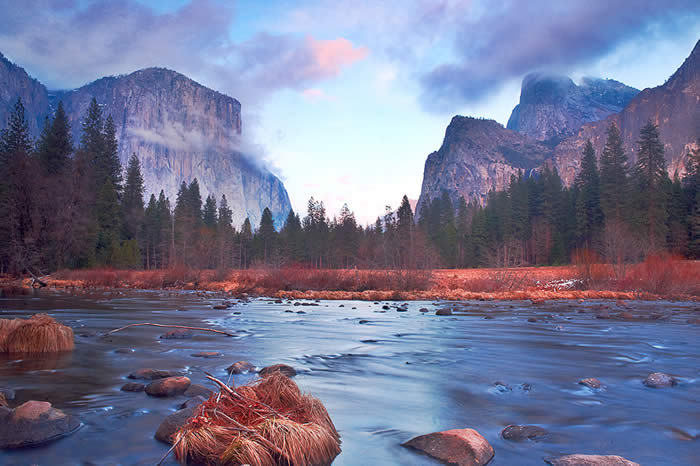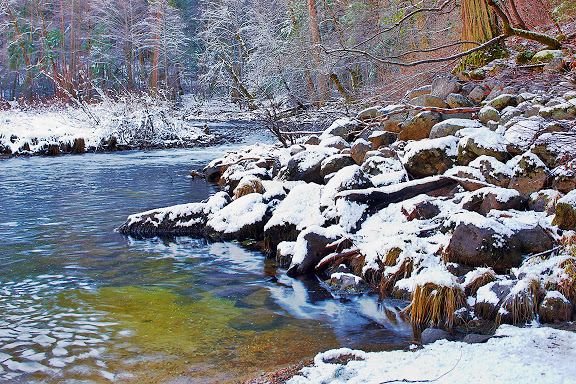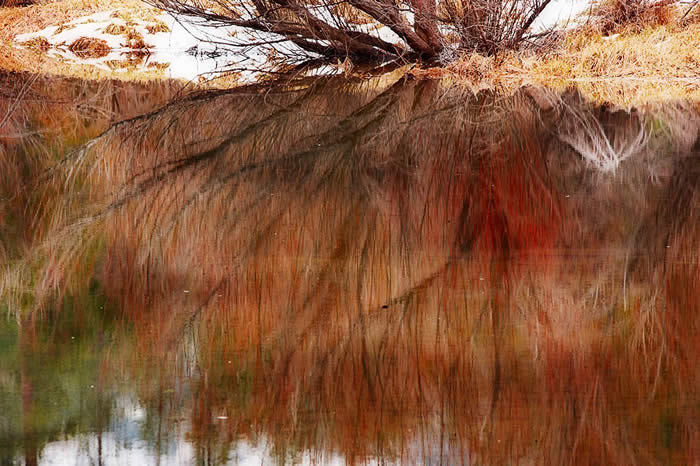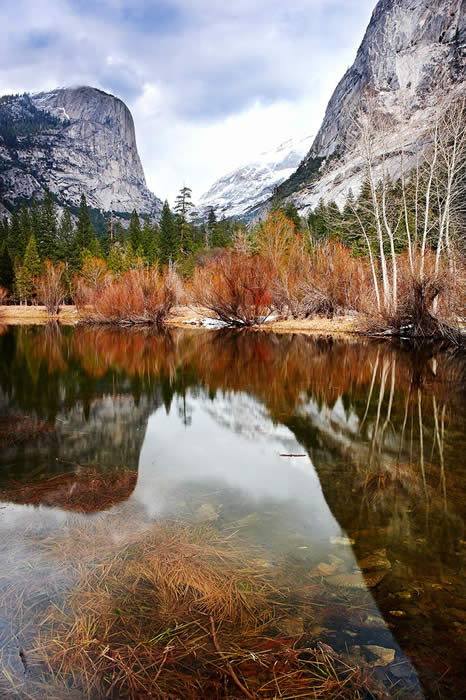When Shooting Plans Change
Yosemite Valley is the best seven miles on the planet! I have believed that since my first visit in 1980. The park itself is vast and almost all wilderness. It is a wonderland of granite and water with sheer cliffs, beautiful waterfalls and lakes. There is no one season that's better than the others, and photographers should experience it in all seasons!
"Each summer I lead a photography workshop to the 'high camps' along Yosemite's mountain ridge line, far removed from the more civilized valley floor. The high country provides more seclusion and tranquility and is quite unique in many ways, but over the years I've come to appreciate the winter months on the valley floor just as much. Every winter the valley seems to provide something different, and this year was no exception. This year it was fall all winter long.
With an elevation of only 4,000 feet, winters in Yosemite Valley don't get a lot of snowfall that stays very long on the valley floor. On the peaks that tower over 9,000 feet directly above the valley, however, there is almost certain to be a heavy snow cover. On the other hand, in the valley the weather is always a guess until we are actually there. Some years we may find snow drifts over our heads and sometimes hardly any cover at all. In the fall, the trees go bare and some of the waterfalls go dormant. When we arrived this past February, we found Yosemite Falls to be a mere trickle in the frozen morning and Horsetail Falls only 'a wet spot.'
The image above of Mt. Watkins reflected in Mirror Lake, was actually 'discovered' as I was photographing the reflected image of the red tree seen in the fourth photo below. This was the opposite of finding a picture within a picture. As I worked the previous image, the sky began to open some and the changing light brought fresh highlights and detail to my attention. As I watched the changing light, I could see that all that was needed to also photograph the image that was surrounding my close-up image was a change of lenses. I then mounted a 35-mm lens on the camera and attached the ColorCombo filter, orienting the filter's built-in polarizer to give a partial view into the river in the foreground without entirely removing the reflection. I then used a 4-stop soft-step Graduated ND filter to hold the marvelous detail of the sky.

"This next image shows one of the iconic views of Yosemite that is always a stopping point for me. Through the seasons, the angle and direction of the light changes dramatically. In many places, this one being a prime example, I could be content to simply leave my camera set up and open a shutter morning, noon and nightfall in every season of the year!
This image, however, presented some challenges. The first was that this popular vantage point on the Merced River had at least a hundred people on the banks to watch the passing storm. Finding a place just to set up proved difficult. The second challenge was the lack of snow cover on the far river bank and meadow which I felt detracted a bit from the scene. Then, in the last few minutes, the solution arose when the scene took on fresh colors as a gloriously muted light found its way through the clouds. A canopy covered us overhead and the soft reflected light set the scene aglow. This effect was so stunning that most of us took time away from our viewfinders just to absorb the spectacle! The movement in the clouds and river were rendered by a 6-second exposure and color heightened with the use of the Singh-Ray Vari-N-Trio and light from the sky balanced with a 4-stop soft-step Graduated ND filter.

There are areas of Yosemite Valley that get little direct sunlight during the winter months. If you know where to find these, they can appear to be in deep winter regardless of the situation elsewhere. Under circumstances such as this very dry winter, finding these locations improves the photographic opportunities and brings fresh detail into the shoot. Here as the Merced River turns and slows, the still and chilled morning air rendered the bare trees on the banks frozen while allowing the trees with leaves to remain green. The color green in any of my compositions, which I find is one of hardest to manipulate in post processing, is always cause to reach for my Singh-Ray Color Intensifier. Wanting to slow the shutter speed while cutting the glare from the water and bright snow, I then decided on the ColorCombo that combines the color intensifier with a warming polarizer to get the three effects I needed to make this image.

On a cloudy day when the sky becomes a canopy of soft reflected light, it almost always leads to images with deeply saturated color. What's more, it takes away heavy shadows that would normally make for difficult exposure problems. That was the kind of light we were working with in the area around Mirror Lake and Meadow. The snow around the base of this mostly bare tree caught my attention and the red glow in the water gave life to the composition. I wanted to work with the red glow but did not want to take away the reflection of the bank. This element was crucial to the composition in my mind. This image was made with the color intensifier, which has no polarization and very little filter factor to be concerned with.
In years such as this one with so little snow on the ground, we are nevertheless grateful that the walking and hiking were made easy. We covered just about all of the valley floor in our 5 days and proved once again that in any season, no matter the weather conditions, Yosemite Valley is the best 7 miles on the planet."
Client Comments
"I been spending some time lately thinking about what what really brings joy into my life. Outdoor photography and all that it encompasses is a very very large part of that In my quiet moments I go to those special places in my mind and remember the feelings I was trying to capture with my camera. I appreciate you introducing me to that world. Our first trip was to Yosemite in the winter. I appreciated you and Tim being so patent with me as I knew very little about photography. It has grown from there. I appreciate the fundamentals you have taught me. It is the best way to do things. The thing I most appreciate is your passion for nature and struggle for survival and beautiful things and beautiful places. For me it was contagious and has added a whole new dimension to my life. You gave me a gift that was unique to you. Steve, I want to thank you for that."

